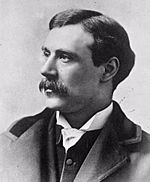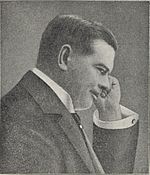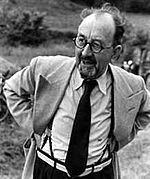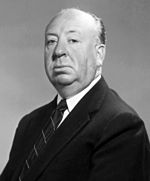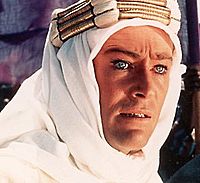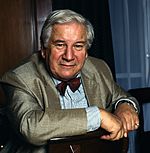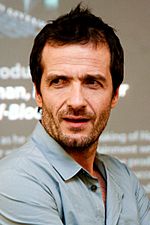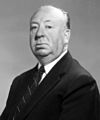Cinema of the United Kingdom facts for kids
Quick facts for kids Cinema of the United Kingdom |
|
|---|---|

|
|
| No. of screens | 4,264 (2017) |
| • Per capita | 7.3 per 100,000 (2017) |
| Main distributors | Walt Disney Studios Motion Pictures StudioCanal Universal Pictures Pathé 20th Century Studios Entertainment One |
| Produced feature films (2017) | |
| Total | 285 |
| Fictional | 213 (74.7%) |
| Animated | 5 (1.8%) |
| Documentary | 66 (23.2%) |
| Number of admissions (2017) | |
| Total | 170,600,000 |
| • Per capita | 2.9 |
| Gross box office (2017) | |
| Total | £1.38 billion |
| National films | £515 million (37.4%) |
The United Kingdom has a long and exciting history in filmmaking. The very first known surviving film, made in 1888, was shot here. Early colour films were also created in the UK.
While many films were made in 1936, the "golden age" of British cinema is often seen as the 1940s. During this time, famous directors like David Lean, Michael Powell, and Carol Reed made some of their best movies. Many British actors have become world-famous, including Audrey Hepburn, Maggie Smith, Michael Caine, Sean Connery, Judi Dench, Daniel Day-Lewis, and Kate Winslet.
Some of the biggest movies ever, like the Harry Potter and James Bond series, were made in the UK. The British film industry has often tried to compete with Hollywood. In 2009, British films earned about $2 billion worldwide. They made up about 7% of the global film market.
The British Film Institute has a list of the 100 greatest British films ever. The annual BAFTA Awards are like the British version of the Academy Awards.
Contents
- History of British Cinema
- Early Days: Silent Films and New Inventions
- The Start of Sound Films
- British Cinema During World War II
- Post-War Golden Age
- Social Realism and the 1960s
- The 1970s and 1980s: Challenges and New Beginnings
- The 1990s: Investment and Rom-Coms
- 2000 to 2010: Global Successes
- 2010 to Present: Changes and Continued Success
- Art Cinema in Britain
- Film Technology and Special Effects
- Images for kids
- See also
History of British Cinema
Early Days: Silent Films and New Inventions
The very first moving picture was filmed in Leeds by Louis Le Prince in 1888. Soon after, in 1889, British inventor William Friese Greene made the first moving pictures on celluloid film in Hyde Park, London. He patented his process in 1890.
Robert W. Paul and Birt Acres built the first working 35mm camera in Britain. They made the first British film, Incident at Clovelly Cottage, in February 1895. Many British film companies quickly started up to make new movies.
Early British films showed everyday events. But by the early 1900s, short story films, mostly comedies and dramas, became popular. These often retold famous stories like Shakespeare plays or Dickens novels.
The famous Lumière brothers brought their film show to London in 1896. In 1898, American producer Charles Urban started making British films, mainly documentaries and news. He later created his own company and produced early colour films using his Kinemacolor process.
Many important studios were founded around this time. Gaumont British Picture Corp. started in 1898 and built Lime Grove Studios in 1915. This was the first building in Britain made just for film production. Hepworth Studios was also founded in 1898.
In 1902, Ealing Studios was founded. It is the oldest continuously operating film studio in the world. Also in 1902, the earliest known colour film was made by Edward Raymond Turner from London. It was found in 2012 after being forgotten for over 100 years.
In 1903, Frank Mottershaw made A Daring Daylight Robbery, which helped start the "chase" film style. By the mid-1920s, British films faced tough competition from the United States. In 1914, 25% of films in the UK were British, but by 1926, this dropped to just 5%.
To help the industry, the Cinematograph Films Act 1927 was passed. It required cinemas to show a certain percentage of British films. This led to "quota quickies" – low-quality films made just to meet the quota. However, some filmmakers, like Michael Powell, learned their skills making these films. The biggest silent film star, English comedian Charlie Chaplin, became famous in Hollywood.
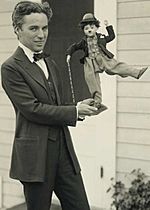
The Start of Sound Films
In 1927, John Maxwell founded British International Pictures (BIP). One of their first films was Alfred Hitchcock's Blackmail (1929). It's often seen as the first British sound film, though it only had some talking parts. Earlier in 1929, The Clue of the New Pin was the first all-talking British movie.
With sound films, actors with clear English accents became more popular. The period also saw the rise of documentary films. John Grierson created the term "documentary" for non-fiction films. His famous early works include Drifters (1929) and Night Mail (1936).
Comedy films also became very popular, often featuring stars from music halls like George Formby and Gracie Fields. These films were important for keeping spirits up during World War II.
Many big-budget British films in the 1930s were made by London Films, founded by Hungarian filmmaker Alexander Korda. His film The Private Life of Henry VIII (1933) was a big success. Korda also made early Technicolor films like The Drum (1938).
By 1937, the film industry faced money problems. The new Cinematograph Films Act 1938 encouraged making fewer, but higher quality, films. This also led to American companies like MGM-British investing in the UK.
Alfred Hitchcock, known as "Alfred the Great," became famous for thrillers like The 39 Steps (1935) and The Lady Vanishes (1938). He later moved to Hollywood.
British Cinema During World War II
During World War II, British films played a big role in showing the nation's spirit. Documentaries like London Can Take It (1940) showed the Blitz, and Listen to Britain (1942) looked at life on the home front. The Crown Film Unit made many of these.
Many popular films helped shape how people saw the war, such as In Which We Serve (1942) and Millions Like Us (1943). The directing team of The Archers made important films like The Life and Death of Colonel Blimp (1943).
Two Cities Films made films like Laurence Olivier's Henry V (1944). Gainsborough Studios released popular dramas like The Man in Grey (1943). New stars like Margaret Lockwood and James Mason became famous through these films.
Post-War Golden Age
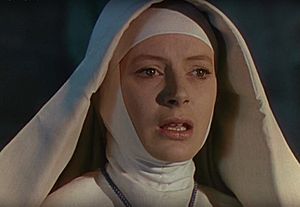
After the war, the Rank Organisation became a major power in British filmmaking. The industry reached new creative heights. Important films from this time include David Lean's Brief Encounter (1945) and his adaptations of Dickens' Great Expectations (1946) and Oliver Twist (1948).
Carol Reed directed thrillers like The Third Man (1949). Powell and Pressburger made A Matter of Life and Death (1946) and The Red Shoes (1948), which was very successful in the US. Laurence Olivier's Hamlet (1948) was the first non-American film to win the Academy Award for Best Picture.
Ealing Studios started making their famous comedies, including Whisky Galore (1948) and The Ladykillers (1955). However, Ealing Studios stopped production in 1958.
In the 1950s, British cinema focused on comedies and World War II dramas for local audiences. War films like The Cruel Sea (1953) and The Dam Busters (1954) made stars of actors like John Mills and Kenneth More.
Popular comedy series included the "Doctor" films, starting with Doctor in the House (1954). The Carry On series began in 1958 and continued for twenty years.
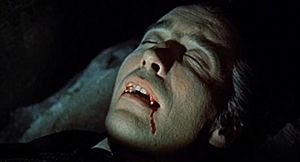
Towards the end of the 1950s, Hammer Films started making successful horror movies. They began with science fiction films like The Quatermass Experiment (1955). Then they moved to gothic horror with The Curse of Frankenstein (1957) and Dracula (1958). Actors Peter Cushing and Christopher Lee often starred in these.
Social Realism and the 1960s
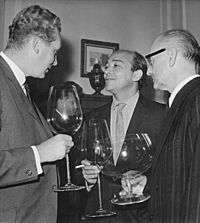
The British New Wave filmmakers, like Karel Reisz, Lindsay Anderson, and Tony Richardson, wanted to make "social realist" films. These movies showed the lives of ordinary people in Britain, often focusing on working-class life and issues that were not usually shown in films.
Films like Reisz's Saturday Night and Sunday Morning (1960) and Anderson's This Sporting Life (1963) are examples of this new style. They brought a fresh, honest look at British society.
In the 1960s, American studios started investing in British films again. They especially liked films that showed the "swinging London" image. Movies like Alfie (1966) explored this exciting time.
The incredibly successful James Bond series began with Dr. No (1962), starring Sean Connery. The series became a global hit, leading to many other spy films. Michael Caine starred as spy Harry Palmer in The Ipcress File (1965).
American directors like Joseph Losey and Stanley Kubrick also worked in the UK. Kubrick made famous films like Dr. Strangelove (1963) and 2001: A Space Odyssey (1968) while living in England. Other European directors also made English-language films in Britain.
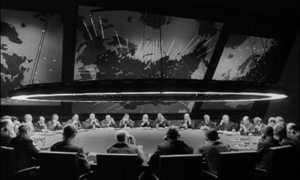
Big historical films like Lawrence of Arabia (1962) and A Man for All Seasons (1966) were made with American money. Four British films won the Best Picture Oscar in the 1960s, including the musical Oliver! (1968).
Ken Loach began his career with social realist films like Poor Cow (1967) and Kes (1969).
The 1970s and 1980s: Challenges and New Beginnings

In the 1970s, American studios reduced their funding for British films. This made it harder to make movies. More relaxed censorship led to some controversial films like A Clockwork Orange (1971). Other notable films included Don't Look Now (1973) and Get Carter (1971).
Alfred Hitchcock returned to Britain to film Frenzy (1972). British horror films, like those from Hammer Film Productions, started to decline. Some British producers turned to making films based on popular TV shows, which were successful with local audiences.
However, major American productions like Star Wars (1977) and Superman (1978) were filmed at British studios. Adaptations of Agatha Christie novels, like Murder on the Orient Express (1974), were also popular.
The early 1980s saw a big drop in film production. Only 31 British films were made in 1980, the lowest number since 1914. This was due to falling cinema attendance and changes in tax rules. However, new independent companies like Goldcrest, HandMade Films, and Merchant Ivory Productions brought new hope.
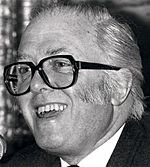
HandMade Films, partly owned by George Harrison, helped make films like Monty Python's Life of Brian and The Long Good Friday (1980). Comedies like Terry Gilliam's Time Bandits (1981) and John Cleese's A Fish Called Wanda (1988) were also popular.

Producer David Puttnam helped a new generation of British directors make successful films. When Chariots of Fire (1981) won four Oscars, including Best Picture, it seemed British cinema was back. Gandhi (1982), another Goldcrest film, also won Best Picture.
This led to many historical films, from big productions like David Lean's A Passage to India (1984) to smaller Merchant Ivory films like A Room with a View (1986). However, some big-budget films like Revolution (1985) lost money.
The 1980s also saw more films from Black and Asian British filmmakers. My Beautiful Laundrette (1985), dealing with racial and gay issues, was a commercial success. Young British actors like Daniel Day-Lewis and Gary Oldman became known as the "Brit Pack".
Channel 4 also started funding films, bringing TV talents like Stephen Frears and Mike Newell into feature films.
The 1990s: Investment and Rom-Coms

Investment in British film production grew a lot in the 1990s. However, much of the money still came from TV broadcasters like the BBC and Channel 4. The film industry often relied on Hollywood for big investments.
Working Title Films, a British company, had a huge international hit with Four Weddings and a Funeral (1994). It earned $244 million worldwide and made Hugh Grant a global star. This film led to more British romantic comedies like Notting Hill (1999).
American producers also invested more in UK-based films. Big Hollywood movies like Mission: Impossible (1996) and Saving Private Ryan (1998) were filmed in the UK.
Successful British films included Merchant Ivory productions like Howards End (1992) and The Remains of the Day (1993). Kenneth Branagh's Shakespeare adaptations and films like The Madness of King George (1994) showed that historical dramas were still popular.
The James Bond films returned with GoldenEye (1995). A new studio was built at Leavesden for the film.
Mike Leigh became a major figure with films about everyday British life, like his big hit Secrets & Lies (1996). New talents like Danny Boyle emerged with films like Trainspotting (1996), which sparked interest in Scottish films.
2000 to 2010: Global Successes
The early 2000s were very successful for British cinema. Many British films reached a wide international audience. Working Title had more hits with romantic comedies like Bridget Jones's Diary (2001) and Love Actually (2003). Mamma Mia! (2008) was a huge global success, earning $601 million.
A major new film series, the Harry Potter films, began in 2001. All of these US-backed but British-made films were shot at Leavesden Studios in England.
Aardman Animations, known for Wallace and Gromit, made successful animated features like Chicken Run (2000) and Wallace & Gromit: The Curse of the Were-Rabbit (2005). The latter won an Academy Award for Best Animated Feature.
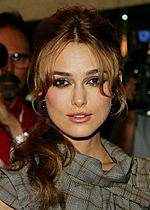
British directors and films won many awards at international festivals. Mike Leigh's Vera Drake (2004) won the Golden Lion at Venice. Stephen Frears' The Queen (2006) won a BAFTA for Best Film. Ken Loach won the Palme d'Or at Cannes for The Wind That Shakes the Barley (2006).
Atonement (2007) won a Golden Globe and BAFTA for Best Film. Slumdog Millionaire (2008), with a British director and team, won eight Oscars, including Best Director and Best Film. The King's Speech (2010), filmed in London, won four Oscars in 2011.
Asian British cinema also became more prominent with films like East Is East (1999) and Bend It Like Beckham (2002). Films about inner-city youth and Black Britons also gained attention, such as Kidulthood (2005) and Adulthood (2008).
Many foreign directors also made films in the UK, including Woody Allen and Alfonso Cuarón. Daniel Craig became the new James Bond in Casino Royale (2006).
British studios like Pinewood, Shepperton, and Leavesden continued to host major international productions, including Batman Begins and Charlie and the Chocolate Factory. In 2010, Warner Bros. bought Leavesden Film Studios, showing a strong commitment to the UK.
2010 to Present: Changes and Continued Success
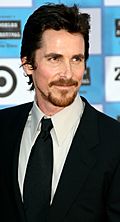
In 2010, the UK Film Council, which supported British cinema, was closed. Its roles were taken over by the British Film Institute. Many actors and professionals protested this decision, including Clint Eastwood, who warned it could reduce foreign films in the UK.
Despite this, the film industry remains important for the British economy. In 2010, over £1.1 billion was spent on UK film production. British films are often highly rated, especially low-budget ones.
In 2012, UK Prime Minister David Cameron said the government wanted the film industry to be even more dynamic. He aimed to help UK producers make successful films that could compete globally.
The most successful British directors in recent years include Paul Greengrass, Christopher Nolan, Ridley Scott, and David Yates.
Art Cinema in Britain
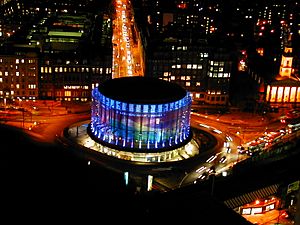
The British Film Institute (BFI) has supported experimental British films since 1952. In 1964, the BFI started a production board, which helped develop British "art cinema" in the 1970s and 80s. This included films by Bill Douglas, Terence Davies, Peter Greenaway, and Derek Jarman.
These art cinema directors often came from art schools. Their work was sometimes experimental and gained success at festivals like Cannes Film Festival and the Academy Awards. Peter Greenaway was one of the first directors to use computer-generated images and film entirely on high-definition video.
When Channel 4 launched its "Film on Four" program, it helped bring art cinema to a wider audience.
Film Technology and Special Effects
British studios became known for amazing special effects in the 1970s and 1980s. Films like Superman (1978), Alien (1979), and Batman (1989) showcased this talent. This reputation grew from the team who worked on 2001: A Space Odyssey (1968).
Thanks to Aardman Animations in Bristol, the UK is a world leader in stop-motion animation. British special effects artists are known for creating visual effects at a lower cost than in the US. This continues with films like the James Bond series, Gladiator (2000), and the Harry Potter films.
Since the 1990s, film production has moved towards digital technology. Special effects, editing, and colour grading are all done digitally. London-based Framestore has worked on challenging projects like The Dark Knight (2008) and Gravity (2013).
High-speed internet allows the British film industry to work closely with US studios on global productions. The British film This Is Not a Love Song (2003) was the first to be streamed live on the Internet at the same time as its cinema premiere.
Images for kids
-
Charlie Chaplin, around 1918.
See also
 In Spanish: Cine del Reino Unido para niños
In Spanish: Cine del Reino Unido para niños


